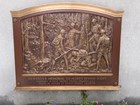Salem Maritime National Historic Site partnered with the Massachusetts National Guard to explore their shared history. Learn about citizen soldiers and the birth of the Massachusetts National Guard—the nation's first.
-
Salem Maritime National Historical Park
Article 1: Military Dogs

Military dogs have always been an important part of soldier’s lives on the front. Sergeant (Sgt.) Stubby, a stray Boston Terrier mix, became the mascot for the 102nd regiment, 26th (Yankee) Division in World War I. Read more
-
Salem Maritime National Historical Park
Article 2: Baltimore Riot

This uniform coat was worn by a member of Company G of the 6th Massachusetts Regiment on April 19, 1861. On that day, the 86th anniversary of the Battle of Lexington and Concord, the Massachusetts 6th Regiment was on its way from Boston to Washington DC to defend the Capitol in response to the Confederates firing on Fort Sumter. Read more
-
Salem Maritime National Historical Park
Article 3: Powder Horn

Powder horns carried extra gunpowder for the flintlock muskets then in use by the Massachusetts Militia. Many powder horns from this period are heavily decorated. This one is much simpler, but very charming. Read more
-
Salem Maritime National Historical Park
Article 4: WWI Victory Parade

On April 25, 1919, Boston welcomed the soldiers of the 26th (Yankee) Division back from a year of hard fighting on the front in France. It was the largest military parade in Boston’s history, with 20,000 soldiers marching or being driven in convertibles if they were wounded, and over a million people lining the streets on a rainy day. Read more
-
Salem Maritime National Historical Park
Article 5: War Correspondents
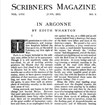
In the era before the internet, newspapers and magazines were how the folks at home learned about what the troops were doing. From the Civil War through the present day, men and women joined the troops, sometime putting themselves in harm’s way to report on the condition at the front for newspapers and magazines back home. Read more
-
Salem Maritime National Historical Park
Article 6: VE Day
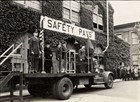
VE Day—May 8, 1945—is the day that Germany and the other Axis powers surrendered to the Allies. For many Massachusetts National Guard soldiers and their families, it was the end of many years of service and anxiety. Read more
-
Salem Maritime National Historical Park
Article 7: Knapsacks
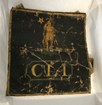
Knapsacks or backpacks have been an important part of a soldier’s equipment for centuries, used to carry clothing and supplies while on the march. Before waterproof fabric was invented, knapsacks were often made of heavy canvas that was painted to protect the contents from water. Read more
-
Salem Maritime National Historical Park
Article 8: 5th Ranger Battalion
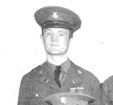
D-Day–June 6, 1944–saw the launch of Operation Overlord, the massive Allied invasion of France. One of the first units to land on Normandy was the 5th Ranger Battalion, whose mission was to eliminate German defenses and clear the path for follow-on forces. Read more
-
Salem Maritime National Historical Park
Article 9: Croix de Guerre

For their gallantry, the 104th Infantry Regiment was given the Croix de Guerre on April 28, 1918. The Croix de Guerre is a French military award created during World War I. It can be awarded to individuals and units both from France and from allied nations for valiant service in action. Read more
-
Salem Maritime National Historical Park
Article 10: Flag Day

Flags, or colors, have traditionally been very important to the military. Military units would usually be issued with two flags, the United States flag, and a state or unit flag. Through the end of the 19th century, a regiment’s colors would be carried onto the field to provide a visual marker of their position on the field of battle. Read more
-
Salem Maritime National Historical Park
Article 11: The Great Salem Fire of 1914
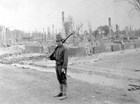
At 1:37 PM on June 25, 1914, a fire started in a leather factory on Boston Street in Salem. At 2:31PM the fire was out of control and Salem’s National Guard unit, the Second Corps Cadets, was called into service. Read more
-
Salem Maritime National Historical Park
Article 12: Military Flyovers

The Fourth of July is celebrated around the country with fireworks, parades, and of course the military flyover, where military aircrafts like the F-15C Eagles flown by the Massachusetts Air National Guard’s 104th Fighter Wing fly in formation over celebrations. Read more
-
Article 13: Pike Point

In early 17th century Massachusetts, every able-bodied male between 16 and 60 was required to attend militia drill once a month except during the harvest months of July and August. One of the main weapons for European armies at the time was the pike, a wooden pole about 16 feet long with a sharp metal point on the end. Read more
-
Salem Maritime National Historical Park
Article 14: Sword Hilt
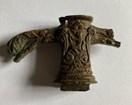
From the late 17th through the 18th centuries, one of the accessories carried by gentlemen was a smallsword, a smaller version of the rapier. Militia officers would carry them as a badge of rank throughout the 18th century. Read more
-
Salem Maritime National Historical Park
Article 15: Olympians

The first Olympics of the modern era was held in Greece in 1896, and the qualifications to enter were somewhat more casual than they are today! The American team was mostly made up of members of the Boston Athletic Association, along with athletes from Harvard and Princeton. Read more
-
Salem Maritime National Historical Park
Article 16: Military Music

In the 19th century, summertime was encampment season. Units would march out to the country for a week or so and train. However, these encampments were also social events, marked by dinners, balls, and band concerts, as many of the wealthier units had their own bands. Read more
-
Salem Maritime National Historical Park
Article 17: Private Albert Edward Scott
“Scotty” was only 15 years old and a freshman at Brookline High School when he lied about his age to a recruiter and went to France with Co. H of the 101st Infantry Regiment in 1917. On July 23, 1918, the 26th (Yankee) Division was advancing near Chateau-Thierry when his company came across a German unit. PFC Scott ended up alone on his unit’s flank and killed 30 attacking German soldiers before he himself was killed by a sniper. Read more
-
Salem Maritime National Historical Park
Article 18: Colonel Lloyd Godfrey

Lloyd Godfrey was born in Boston in 1919, the son of Jamaican immigrants. At the beginning of World War II, he was working as a machinist at the Charlestown Navy Yard and had just married his wife Ruby when he decided to join the elite group of African Americans training to be airmen at the Tuskegee Airfield in Alabama. Read more

